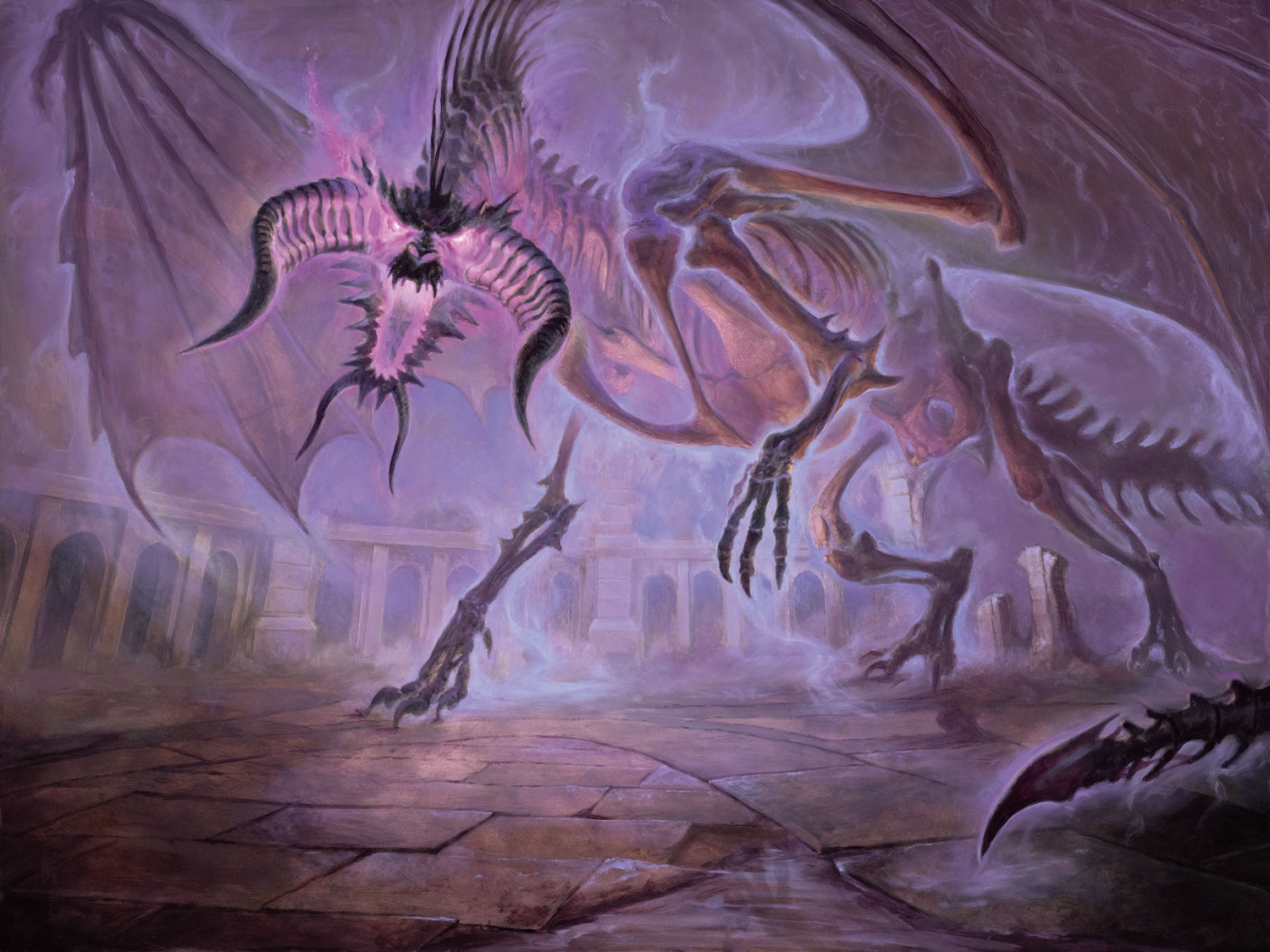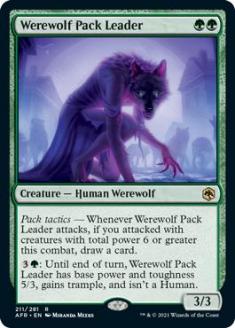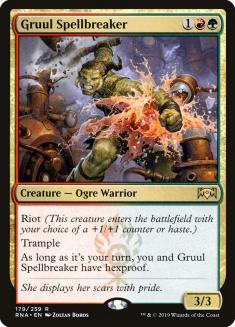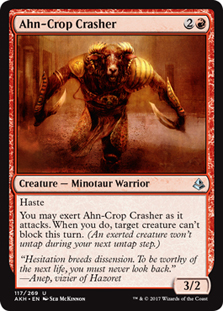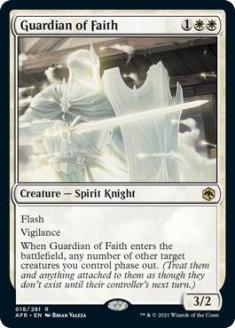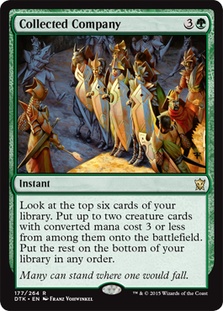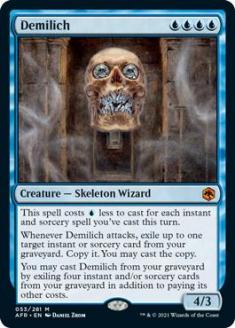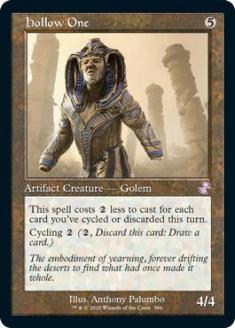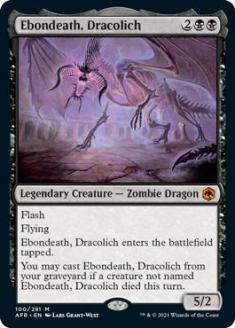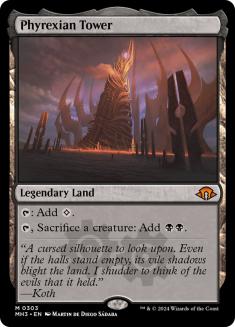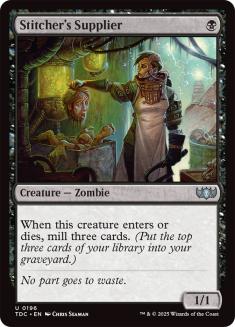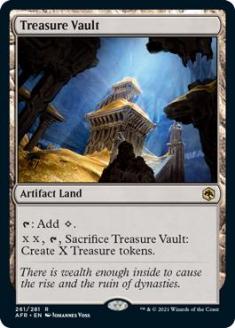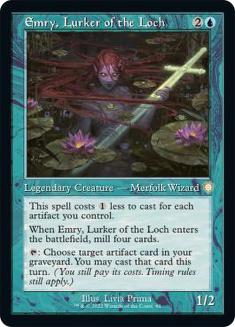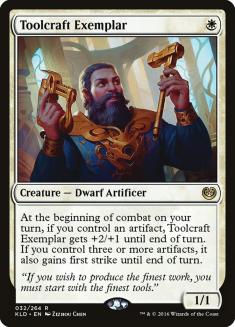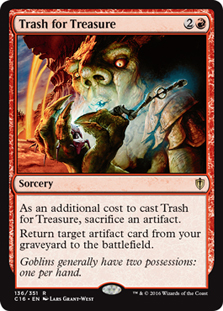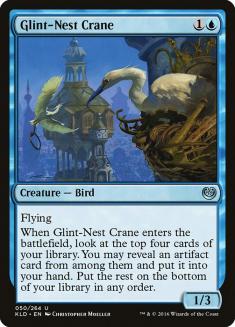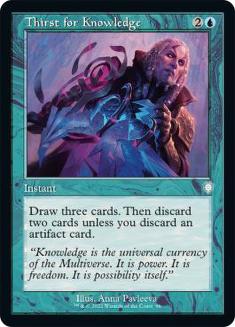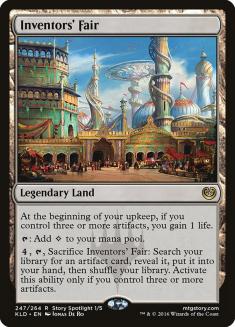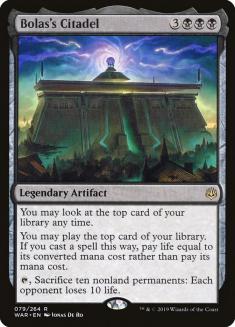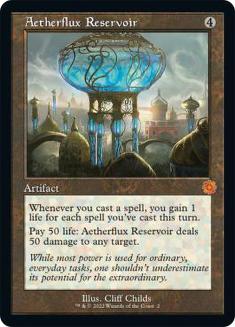From the looks of it, Adventures in the Forgotten Realms seems to be a low-powered set; we’re getting another Strixhaven rather than another Throne of Eldraine. Even then, there are a couple of cards that I believe can find their way into some current existing Historic decks. Lets get to it.
Werewolf Pack Leader
Werewolf Pack Leader is a pretty strong card and Gruul Aggro decks are the perfect home for it. Here’s how I would build the deck:
Creatures (34)
- 4 Llanowar Elves
- 2 Scavenging Ooze
- 4 Burning-Tree Emissary
- 4 Voltaic Brawler
- 3 Ahn-Crop Crasher
- 4 Pelt Collector
- 4 Gruul Spellbreaker
- 1 Questing Beast
- 4 Bonecrusher Giant
- 1 Kazandu Mammoth
- 3 Werewolf Pack Leader
Lands (13)
Spells (13)
Sideboard

As a 3/3, it gets to dodge some of the most commonly played removal spells (Prismari Command, Pillar of Flame, Shock), but the reason I’m excited about it is that the Gruul deck has a number of ways to activate Werewolf Pack Leader’s ability on Turn 3, including two three-power haste creatures (Gruul Spellbreaker and Ahn-Crop Crasher).
Curving Turn 2 Werewolf Pack Leader into either of these creatures on Turn 3 will immediately give you a card back, and then you threaten to trigger it every turn of the game while the Pack Leader stays on the battlefield. Outside of that, there are also potential Turn 1 Pelt Collector turns that will translate into triggering this on Turn 3, as well as Llanowar Elves + Burning-Tree Emissary Turn 2s.
The pump ability isn’t going to be the most relevant, but it can definitely come up, especially if it’s a long game and you’re looking for a big creature to Embercleave. The most likely scenario for it coming up is getting an extra Pelt Collector trigger. It used to be hard to get it above 4/4 but now there’s an ordinary way for a five-power creature to die, which can bring it to a 5/5.
The biggest problem with Werewolf Pack Leader in the Gruul deck is its anti-synergy with Burning-Tree Emissary. If we’re playing Voltaic Brawler or Zhur-Taa Goblin, then we can play those alongside Burning-Tree Emissary on Turn 2, but with Werewolf Pack Leader we can’t do that unless we have Llanowar Elves. This is an issue, but not an insurmountable one. I believe that, if the Pack Leader cost RG (or if the Emissary produced RR), then we’d be playing four copies of the Werewolf, but I’m going to try three copies for now because of the Emissary issue. It wouldn’t shock me if the card was strong enough for four copies anyway, though.
Guardian of Faith
We’ve seen several different variations of this effect (ranging from instants like Ghostway to most recently Glorious Protector), but I believe Guardian of Faith has the potential to be the best of them in Historic for two reasons. The first, and most important, is that it works with Collected Company.
As a “fair creature”, Guardian of Faith is not the best – a 3/2 Flash Vigilance for 3 is nothing to write home about – but if you ever get to save a single one of your creatures (from a removal spell or from combat) then you’ve gotten more than your money’s worth. Sometimes your opponent is going to cast a Fatal Push or a Lightning Helix and you’re going to have Guardian of Faith for a blowout, and sometimes you’re going to Company into it to save your creature.
As an anti-sweeper measure (which is the main purpose of a card like this in a creature deck), Guardian of Faith and Collected Company interact somewhat weirdly. You can Company in response to their Wrath of God, but if you miss you really miss (since your new Company hits will be dead as well), so most of the time you’re going to let the Wrath resolve and then cast the Company unless you’re in a dire spot, but this doesn’t mean there isn’t synergy there, because Guardian of Faith is a Wrath answer that you can play without going too low on Company hits.
Whenever you play a Collected Company deck, you always have to be mindful of lowering your creature count post sideboard. When we played Jund Company, for example, that was often a problem. Guardian of Faith is an answer to a problematic style of card (a sweeper) that you can play while keeping your creature count high, and that’s something that didn’t exist before. You could play Glorious Protector, and these decks often did, but if you ever Company into a Glorious Protector it’s a brick, so there’s a limit to how many of this type of card you can afford to have. So, even though hitting Guardian of Faith with Company is unlikely to save you from Wrath, the fact that it’s hittable by Company means you can play a lot of them to begin with.
The second reason it might be better than what we’ve had before is that phasing is different from blinking because it lasts until your next turn, which might prevent your creatures from being hit by something. Imagine, for example, that you attack and your opponent casts Lightning Helix on your creature. If you have Guardian of Faith, you can play it and save your creature from Lightning Helix, while also knowing that it will be safe from Wrath of God next turn. In a deck with Reidane, God of the Worthy, Thalia, Hero of Thraben, and Elite Spellbinder, you’re often incentivized to Company on your turn to disrupt them, and if you hit Guardian of Faith you’ll be able to save your creatures from Wrath next turn anyway.
I wouldn’t maindeck any Guardian of Faith in Selesnya Company right now, but I would play three or four copies in the sideboard and I’d expect them to be pretty good versus decks with sorcery-speed sweepers.
Creatures (34)
- 4 Llanowar Elves
- 2 Scavenging Ooze
- 3 Thalia, Guardian of Thraben
- 4 Adanto Vanguard
- 4 Lovestruck Beast
- 4 Archon of Emeria
- 4 Luminarch Aspirant
- 4 Kazandu Mammoth
- 1 Reidane, God of the Worthy
- 4 Elite Spellbinder
Lands (12)
Spells (14)

Demilich
Demilich is a very polarizing card. Some people say it’s broken and will be banned immediately and some people say it does absolutely nothing. The truth, like in most cases, will probably fall somewhere in the middle. Most people seem to focus on the “replay a spell” clause of it, but I sort of see it like a Hollow One; you’re going to do whatever it is you were doing anyway and then you’ll drop one or two of those bad boys for free (sometimes from the graveyard).
Unfortunately we don’t have Gitaxian Probe, Manamorphose or Lava Dart to accelerate Demilich, so we’re not going to get it onto the battlefield before Turn 4, but playing one or two of those for free on Turn 4 is very doable. The most obvious home is Izzet Phoenix, which is a deck that’s already focused on playing lots of spells and that already has graveyard synergy (so you can mill or discard Demilich and then recast it if you want). Besides, the card works exceedingly well with Finale of Promise.
The biggest challenge here is deciding how many Demiliches you play. It works well in multiples because, once you’ve done the work for one of them you’ve done the work for all of them, but at the same time having more creatures makes each future copy less likely to work, since you might just end up flooded with creatures. It also makes graveyard hate more effective against you.
I feel that, at least to start with, people should be playing four copies of the card. Its text is just an amalgamation of abilities that have been broken individually in the past, so we should push it to the max and see how good it can really be on a dedicated list — that’s generally the right approach for cards that have the potential to be very good. Then, if it turns out four copies is too clunky and you miss the other evasive creatures, we can reassess and lower the numbers.
Creatures (14)
Lands (16)
Spells (30)

Ebondeath, Dracolich
Ebondeath, Dracolich is a bit of a long shot, but, as I mentioned when I was talking about Demilich, some card texts just have “broken” all over them, and “you may cast CARDNAME from your graveyard” is one of those. Dracolich is not castable at will from the graveyard, but in the right deck it seems almost trivial to do so without any help from your opponent.
The card I’m most interested in here is Phyrexian Tower, particularly in combination with Stitcher’s Supplier.
If you have a Turn 1 Stitcher’s Supplier and you mill Ebondeath, Dracolich, you can simply sacrifice the Supplier on Turn 3 to bring back the Dragon. A five power flyer is nothing to scoff at, and in this sequence it doesn’t really cost you anything; you’re simply doing things you were already interested in doing. Similarly, you could throw this in the graveyard somehow and then sacrifice a Cauldron Familiar to a Witch’s Oven and bring it back en passant.
The key with Ebondeath, Dracolich is that it’s likely not good enough at being your main game plan, but it might be very good at being your secondary plan. The goal should not be to cheat Ebondeath onto the battlefield like the Phoenix decks try to do with Arclight Phoenix. It should simply be a backup plan in case your main plan falls through.
The deck that catches my eye the most here is an old favorite that hasn’t seen much play lately — Mono Black God-Pharaoh’s Gift. The deck naturally runs a lot of sacrifice effects (Phyrexian Tower, Woe Strider) and discard enablers (Cryptbreaker, Gate to the Afterlife), as well as self-mill, so it’s the perfect spot for Ebondeath. Another alternative would be the Rakdos Arcanist decks, though in those it’s going to be a bit harder to cast.
Creatures (30)
- 2 Massacre Wurm
- 4 Cryptbreaker
- 3 Ravenous Chupacabra
- 4 Stitcher's Supplier
- 4 Priest of Forgotten Gods
- 4 Lazotep Reaver
- 4 Woe Strider
- 3 Fiend Artisan
- 2 Ebondeath, Dracolich
Lands (20)
- 16 Swamp
- 4 Phyrexian Tower
Spells (10)

The biggest concern about the card is that it matches up poorly versus Izzet Phoenix because of Arclight Phoenix and Pillar of Flame. It’s also not the best at dealing with Prismari Command, since it dies to that and might take your artifact alongside it. Still, it’s interesting enough of a card that I feel it’s worth mentioning.
Treasure Vault
Modern players might be used to having Darksteel Citadel, but Historic players have never had an artifact land and now we do! I’m not interested in the effect itself as much as the fact that this can facilitate a host of artifact synergies. Here are some potential interactions, some more and some less likely to show up (note that it does not work with Indomitable Creativity because you just end up revealing more copies of it):
Not that long ago, I saw Jim Davis stream with a Trash for Treasure deck that would almost certainly want Treasure Vault to enable it. Here’s a sample list (almost identical to his) with the new artifact land:
Creatures (12)
Lands (6)
Spells (42)

In case you’re not sure what’s going on, the goal of this deck is to cheat a Bolas’s Citadel onto the battlefield and then basically go off with Aetherflux Reservoir. The easiest way to accomplish that is to discard Citadel and then Trash for Treasure it, which makes Treasure Vault a potentially good addition.
Past that, I’m mostly interested in the reliability of casting a Turn 2 Emry, Lurker of the Loch. Treasure Vault makes that very easy, though what the best shell for that is I don’t know yet.
Treasure Vault is a bit dangerous right now because of Prismari Command, but having a free artifact is a very powerful effect that is worth keeping an eye on in the future. It would not surprise me if this card becomes an integral part of a very successful strategy.
Overall, it seems unlikely that any Adventures in the Forgotten Realms cards will end up shaking up Historic too much, but at least some of them look like they can be improvements to existing decks, and others look like they can be centerpieces of future decks that we should keep an eye out for.

